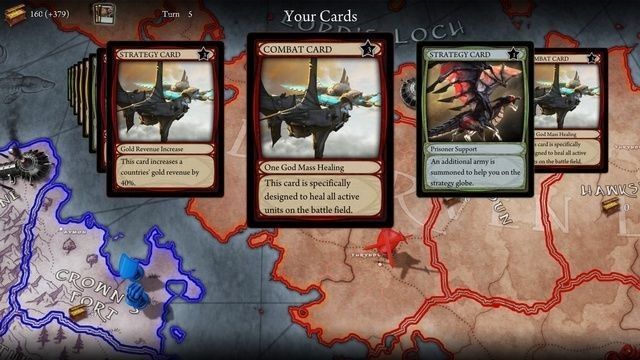Flying around in the air as a jet-pack dragon and commanding airships isn’t actually that fun, at least not in the long-term. Larian really went back to basics and came up with a new way to present Dragon Commander, one that – having play tested a couple of matches – we can say actually works quite well. Instead of taking places in the skies, Dragon Commander is now fought on land-based battlefields, filled with bases, capture points, and lots of mountains and other environmental factors that make it more of a true real-time strategy/tactics experience than simply a quirky Dragon simulator. This only serves as a tactical battle map though, secondary to the main show which is the strategic map. Think of how Total War does it (but old school Total War, before Rome’s 3D map came in), and you’re in the right neighbourhood. On the strategic map you build units – which can range from everything from ‘infantry’ walkers, to ranks and artillery, to war zeppelins and even powerful battle ships.
 |
| Cards add new dimensions to your strategy, and you gain them through-out the game |
There are a lot of elements in this game – a basic economy drives a respectable empire management system, where you can build buildings, or capture regions that have buildings already in them. Factories allow you to build units, and capturing/building one can allow you to open up another front, Tavern’s allow you to gain Mercenary cards, and so on. You move your armies about the map in true TBS style; although you have to make sure units aren’t caught out on their own otherwise they’ll be trashed. There’s also the RPG system – which is one of the few things that hasn’t changed that much since we last saw it. At the end of the day, you’re playing as a Dragon Knight, and your goal is to not only unite the races of Rivellon, but also to defeat your grand enemy. Dragon Commander doesn’t sound like it has the greatest plot in the world – basically your overall goal is to get rid of the very steampunk technology you used to win it, returning Rivellon to its more traditional High Fantasy state. Imagine if Divinity II had tanks and artillery… would have made an interesting game.
There are also compromises that you have to make – do you develop your army, or do you develop yourself as a Dragon Knight? That’s not to say that you have to do one, or the other, but developing new Dragon abilities and developing technologies for your armies cost resources, and you’ll only have a finite amount turn-by-turn. Do you give your scout buggies rocket pods, or do you give yourself the ability to fire a nuke-like fireball from your mouth? Decisions, decisions. Most of the story in Dragon Commander unfolds on your flagship, which is separated into several areas – War Room, your personal quarters, engineering, and so on… there are a loads of weird and wonderful characters for you to meet and interact with, and they’ll all give you insights into the world, offer you advice, or even give you moral challenges that you have to make decisions. There’s a lot of socio-political commentary in this game, which can be an amusing distraction.
 |
| War. War never changes... |
But that’s not to say the Dragon’s with their Jetpacks are gone – not at all. Now that the rest of the game is fully fleshed out and there to see, playing as the Dragon is actually a relatively small part of the game. During tactical battles, you can seamlessly jump in and out of the action by ‘spawning’ your dragon form, and you can fly around and muck stuff up for as long as you want, or until you’re shot down by opposing forces, in which case there’s a small cool-down. You’ll encounter other Dragon Commanders in your war for Rivellon, and in Multiplayer especially things become really interesting. During our play-time we had a two on two contest on a test strategy map, and in the tactical battle we were all jumping in and out of Dragon form, either to cause mischief, or to deal with an enemy. Thing is, you don’t want to be spending too much time in Dragon mode as you’ll be unable to direct the rest of your army.
Dragon Commander is looking a much stronger game, there’s no doubt about it. Personally, we’re glad that Larian took the time to make sure they got it right. With its Total War-esq grand strategy interface, to its tactical mode that proves to be extremely engaging, this is going to be a really interesting spin-off title to a much-loved franchise. We haven’t even talked about the card system – which adds a whole new dimension to strategy by giving you temporary buffs for a turn to help turn the tide, or screw over your enemy. Whilst this game is really only being used to fund Original Sin, we hope this isn’t the last we see of the Dragon Commander’s and their improbable steampunk jetpacks. Divinity: Dragon Commander is due out in Q2 2013.
Most Anticipated Feature: We only got to see one tactical map; we’re interested in seeing how much variance there is, and what options that gives for playing them out.




